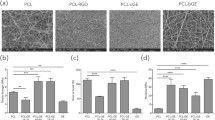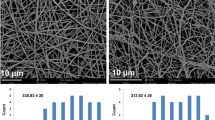Abstract
Every year, millions of people suffer from dermal wounds caused by heat, fire, chemicals, electricity, ultraviolet radiation or disease. Tissue engineering and nanotechnology have enabled the engineering of nanostructured materials to meet the current challenges in skin treatments owing to such rising occurrences of accidental damages, skin diseases and defects. The abundance and accessibility of adipose derived stem cells (ADSCs) may prove to be novel cell therapeutics for skin regeneration. The nanofibrous PVA/gelatin/azide scaffolds were then fabricated by electrospinning using water as solvent and allowed to undergo click reaction. The scaffolds were characterized by SEM, contact angle and FTIR. The cell–scaffold interactions were analyzed by cell proliferation and the results observed that the rate of cell proliferation was significantly increased (P ≤ 0.05) on PVA/gelatin/azide scaffolds compared to PVA/gelatin nanofibers. In the present study, manipulating the biochemical cues by the addition of an induction medium, in combination with environmental and physical factors of the culture substrate by functionalizing with click moieties, we were able to drive ADSCs into epidermal lineage with the development of epidermis-like structures, was further confirmed by the expression of early and intermediate epidermal differentiation markers like keratin and filaggrin. This study not only provides an insight into the design of a site-specific niche-like microenvironment for stem cell lineage commitment, but also sheds light on the therapeutic application of an alternative cell source—ADSCs, for wound healing and skin tissue reconstitution.





Similar content being viewed by others
References
Rostovtsev VV, Green LG, Fokin VV, Sharpless KB. A stepwise Huisgen cycloaddition process: copper(I)-catalyzed regioselective “ligation” of azides and terminal alkynes. Angew Chem Int Ed. 2002;41:2596–9.
Lutz JF, Zarafshani Z. Efficient construction of therapeutics, bioconjugates, biomaterials and bioactive surfaces using azide–alkyne “click” chemistry. Adv Drug Deliv Rev. 2008;60(9):958–70.
Kolb HC, Sharpless KB. The growing impact of click chemistry on drug discovery. Drug Discov Today. 2003;8(24):1128–37.
Raeber GP, Lutolf MP, Hubbell JA. Molecularly engineered PEG hydrogels: a novel model system for proteolytically mediated cell migration. Biophys J. 2005;89:1374–88.
Chen J, Zhang Y, Du GC, Hua ZZ, Zhu Y. Biodegradation of polyvinyl alcohol by a mixed microbial culture. Enzyme Microb Technol. 2007;40:1686–91.
Koski A, Yim K, Shivkumar S. Effect of molecular weight on fibrous PVA produced by electrospinning. Mater Lett. 2004;58:493–7.
Chiellini E, Corti A, D’Antone S, Solaro R. Biodegradation of poly(vinyl alcohol) based materials. Prog Polym Sci. 2003;28:963–1014.
Paradossi G, Cavalieri F, Chiessi E, Spagnoli C, Cowman M. Poly(vinyl alcohol) as versatile biomaterial for potential biomedical applications. J Mater Sci Mater Med. 2003;14:687–91.
Martin P. Wound healing: aiming for perfect skin regeneration. Science. 1997;276:75–81.
Falanga V. Wound healing and its impairment in the diabetic foot. Lancet. 2005;366:1736–43.
Wu Y, Chen L, Scott PG, Tredget EE. Mesenchymal stem cells enhance wound healing through differentiation and angiogenesis. Stem Cells. 2007;25(10):2648–59.
Laco F, Kun M, Weber HJ, Ramakrishna S, Chan CK. The dose effect of human bone marrow-derived mesenchymal stem cells on epidermal development in organotypic co-culture. J Dermatol Sci. 2009;55(3):150–60.
Rustad K, Wong VW, Sorkin M, Glotzbach JP, Nehama D, Major MR, Rajadas J, Longaker MT, Gurtner GC. Delivery of mesenchymal stem cells in a biomimetic collagen hydrogel enhances cutaneous wound healing. J Am Coll Surg. 2010;211:S91–2.
Kobayashi M, Spector M. In vitro response of the bone marrow-derived mesenchymal stem cells seeded in a type-I collagen–glycosaminoglycan scaffold for skin wound repair under the mechanical loading condition. Mol Cell Biomech. 2009;6:217–28.
Păunescu V, Deak E, Herman D, Siska IR, Tănasie G, Bunu C, Anghel S, Tatu CA, Oprea TI, Henschler R, Rüster B, Bistrian R, Seifried E. In vitro differentiation of human mesenchymal stem cells to epithelial lineage. J Cell Mol Med. 2007;11:502–8.
Ma K, Laco F, Ramakrishna S, Liao S, Chan CK. Differentiation of bone marrow-derived mesenchymal stem cells into multi-layered epidermis-like cells in 3D organotypic coculture. Biomaterials. 2009;30:3521–8.
Scadden DT. The stem-cell niche as an entity of action. Nature. 2006;441(7097):1075–9.
Schneider RKM, Neuss S, Stainforth R, Laddach N, Bovi M, Knuechel R, Perez-Bouza A. Three-dimensional epidermis-like growth of human mesenchymal stem cells on dermal equivalents: contribution to tissue organization by adaptation of myofibroblastic phenotype and function. Differentiation. 2008;76(2):156–67.
Ravichandran R, Venugopal JR, Sundarrajan S, Mukherjee S, Ramakrishna S. Precipitation of nanohydroxyapatite on PLLA/PBLG/collagen nanofibrous structures for the differentiation of adipose derived stem cells to osteogenic lineage. Biomaterials. 2012;33(3):846–55.
Ravichandran R, Venugopal JR, Sundarrajan S, Mukherjee S, Sridhar R, Ramakrishna S. Composite poly-l-lactic acid/poly-(α, β)-dl-aspartic acid/collagen nanofibrous scaffolds for dermal tissue regeneration. Mater Sci Eng C. 2012;32(6):1443–51.
Ravichandran R, Ng CCh, Liao S, Pliszka D, Raghunath M, Ramakrishna S, Chan CK. Biomimetic surface modification of titanium surfaces for early cell capture by advanced electrospinning. Biomed Mater. 2012;7(1):015001.
Ravichandran R, Venugopal JR, Sundarrajan S, Mukherjee S, Ramakrishna S. Poly(glycerol sebacate)/gelatin core/shell fibrous structure for regeneration of myocardial infarction. Tissue Eng Part A. 2011;17(9–10):1363–73.
Ravichandran R, Venugopal JR, Sundarrajan S, Mukherjee S, Sridhar R, Ramakrishna S. Expression of cardiac proteins in neonatal cardiomyocytes on PGS/fibrinogen core/shell substrate for cardiac tissue engineering. Int J Cardiol. 2013;167(4):1461–8.
Ravichandran R, Liao S, Ng CCh, Chan CK, Raghunath M, Ramakrishna S. Effects of nanotopography on stem cell phenotypes. World J Stem cells. 2009;1(1):55–66.
Venugopal J, Low S, Choon AT, Ramakrishna S. Interaction of cells and nanofiber scaffolds in tissue engineering. J Biomed Mater Res B. 2008;84:34–48.
Ravichandran R, Venugopal JR, Sundarrajan S, Mukherjee S, Ramakrishna S. Cardiogenic differentiation of mesenchymal stem cells on elastomeric poly (glycerol sebacate)/collagen core/shell fibers. World J Cardiol. 2013;5(3):28–41.
Shalumon KT, Anulekha KH, Girish CM, Prasanth R, Nair SV, Jayakumar R. Single step electrospinning of chitosan/poly(caprolactone) nanofibers using formic acid/acetone solvent mixture. Carbohydr Polym. 2010;80(2):414–20.
Kolb HC, Finn MG, Sharpless KB. Click chemistry: diverse chemical function from a few good reactions. Angew Chem Int Ed Engl. 2001;40:2004–21.
Tornoe CW, Christensen C, Meldal M. Peptidotriazoles on solid phase: [1,2,3]-triazoles by regiospecific copper(I)-catalyzed 1,3-dipolar cycloadditions of terminal alkynes to azides. J Org Chem. 2002;67:3057–64.
Fusenig N. Effects of mesenchymal cells on keratinocytes. In: Leigh IM, Lane EB, Watt FM, editors. The keratinocyte handbook. London: Cambridge University Press; 1994. p. 79–81.
Mizoguchi M, Suga Y, Sanmano B, Ikeda S, Ogawa H. Organotypic culture and surface plantation using umbilical cord epithelial cells: morphogenesis and expression of differentiation markers mimicking cutaneous epidermis. J Dermatol Sci. 2004;35:199–206.
Jin G, Prabhakaran MP, Ramakrishna S. Stem cell differentiation to epidermal lineages on electrospun nanofibrous substrates for skin tissue engineering. Acta Biomater. 2011;7(8):3113–22.
Green H, Easley K, Luchi S. Marker succession during the development of keratinocytes from cultured human embryonic stem cells. Proc Natl Acad Sci USA. 2003;100:15625–30.
Ji L, Allen-Hoffmann BL, de Pablo JJ, Palecek SP. Generation and differentiation of human embryonic stem cell-derived keratinocyte precursors. Tissue Eng. 2006;12:665–79.
Haase I, Knaup R, Wartenberg M, Sauer H, Hescheler J, Mahrle G. In vitro differentiation of murine embryonic stem cells into keratinocyte-like cells. Eur J Cell Biol. 2007;86(11–12):801–5.
Acknowledgments
This study was supported by the NRF-Technion (R-398-001-065-592), Ministry of Education (R-265-000-318-112) and NUSNNI, National University of Singapore, Singapore.
Author information
Authors and Affiliations
Corresponding author
Electronic supplementary material
Below is the link to the electronic supplementary material.
10856_2013_5031_MOESM1_ESM.tif
Supplementary Figure 1. Optical microscope image of a) ADSCs after isolation with spindle shaped morphology, b) ADSCs showing cuboidal morphology on day 7, c) Keratinocyte-like cells on day 10, d) differentiated keratinocyte-like cells forming colonies (TIFF 2107 kb)
Rights and permissions
About this article
Cite this article
Ravichandran, R., Venugopal, J.R., Sundarrajan, S. et al. Click chemistry approach for fabricating PVA/gelatin nanofibers for the differentiation of ADSCs to keratinocytes. J Mater Sci: Mater Med 24, 2863–2871 (2013). https://doi.org/10.1007/s10856-013-5031-1
Received:
Accepted:
Published:
Issue Date:
DOI: https://doi.org/10.1007/s10856-013-5031-1




